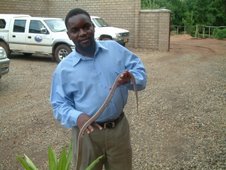
Misa delegates into Malawi’s oldest forest reserve
by Hastings Maloya
They arrived from all member countries of the Media Institute of Southern Africa (MISA). Malawians, as usual, showed their warmth in welcoming and making the visitors feel at home. Sunbird Mount Soche hotel was not a disappointment. For the first time Malawi hosted the regional indaba for scribes and after three days of serious deliberations, an out-of-hotel tour was necessary. The perfect and able conference organising team planned a visit to Mount Mulanje, Malawi’s island in the sky.
Those that had visited different mountains in their home countries thought they had seen the best. As such they might have not been very excited with the programme that indicated a tour to Mulanje Mountain. But when a briefing was made prior to the tour, only doubting delegates could have wanted to prove a point. Can Malawi indeed have such a wonderful resource? A surprise was in the wait!
The tour started soon after lunch. Had it been that the sites were boring, it could have been a perfect recipe for a slumber. But who could close one’s eyes past the Chipembere Highway with exchange of jokes from different countries? There we were, outside Limbe into the Thyolo road, past Bvumbwe and Thunga ~ yes the beauty of the tea fields kept the delegates silent for a while.
“Mr. Driver, please stop, I want to have a feel in my hands of a tea leaf! Oh! this is wonderful,” cried a South African before the plea was chorused by all while those with cameras were doing the actual jobs that the gadgets were made for. A slight wait took the delegates to the historical Mwala wa Nthunzi in Thyolo – a stone on the roadside. The history and stories associated with this stone were not only amazing but lured the visitors to make a special trip to Malawi. However, they were yet to see other things.
The journey had to go on. Past the Thyolo highlands the sight of Mount Mulanje was noted. Those that thought that they had visited mountains before realised that they have only been to hills. Yes the situate of the attractive Mount Mulanje took the delegates all the way past Chitakale trading centre into the Likhubula Valley past the Mulanje District Forest office to the Likhubula CCAP.
Every member wished this trip started in the morning. They wished they could have climbed up Chambe plateau, or at least a visit to the historical Dziwe la Nkhalamba, but time was not available.
Patricia Kawawa of the Likhubula CCAP House was an excellent guide around the place and to the Likhubula pools. She led the delegates into the Likhubula river, where a feel of the fresh waters was a toast of the day for the delegates, with everyone wishing to take a bath – yes if the costumes were available swimming tactics could have been experienced.
“This is just little about Mount Mulanje, there is more inside,” says Patricia to the pain of her visitors as now wished the time of their stay in Malawi was extended.
Time was spent in playing in the cold waters of Likhubula. How about exciting picnic pictures on the rocks of the rivers? Notebooks were looked for, pens in the hand and notes taken… yes the trademark of scribes – out to tell stories. To most of them this was a day they will live to remember.
But all good things have to come to an end. Time to get back to the hotel, but we need a drink…don’t we? Kara O’Mula, one most lovely lodge on the other side of the mountain was host for a mean cocktail. Just crowned up the already lovely day! With all the fascinating sceneries, the mountain left a mark in the minds of many.
Situated about 80 km from the commercial city of Blantyre, the attractive Mulanje with its Sapitwa Peak, standing over 3000m above sea level, is not only the highest mountain but also the most impressive and unique massif in the southern and central African region. It is is much more than a barren rock with its forest reserve thus made up of a range of ecological habitats from rain forest to alpine, woodland to grassland. There is a great diversity of plant and animal life and many of species are endemic. The most famous endemic is the magnificent and endangered Mulanje cedar, Malawi’s National Tree, which dominates the high altitude forests. With its evergreen forests, woodlands and montane grasslands, the mountain has attracted increasing attention to many tourists.
The journalists attested to it. And more to it, back to the hotel, Honourable Aleke Kadonaphani Banda had something in store for them
………ends








No comments:
Post a Comment